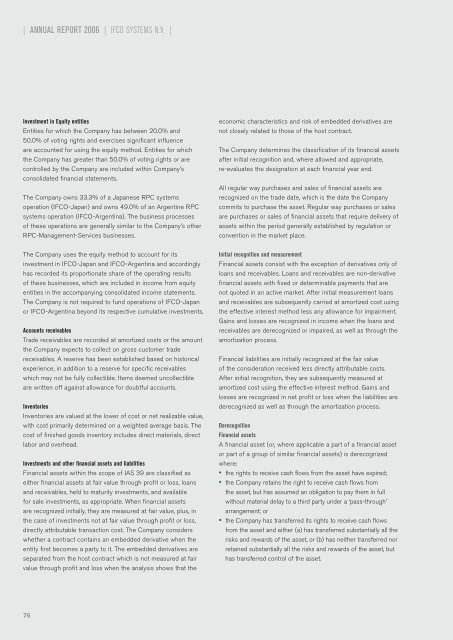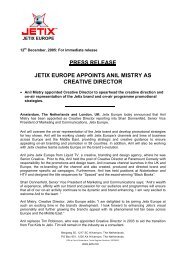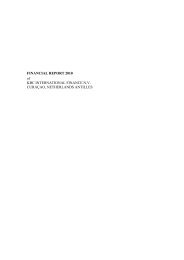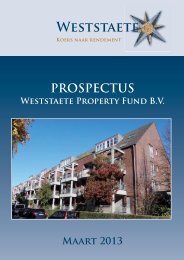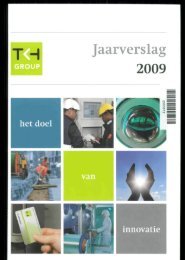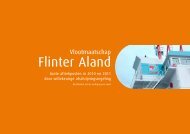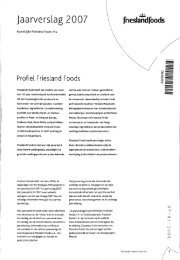Pallet-Management-Services - AFM
Pallet-Management-Services - AFM
Pallet-Management-Services - AFM
You also want an ePaper? Increase the reach of your titles
YUMPU automatically turns print PDFs into web optimized ePapers that Google loves.
| ANNUAL REPORT 2006 | IFCO SYSTEMS N.V. |<br />
Investment in Equity entities<br />
Entities for which the Company has between 20.0% and<br />
50.0% of voting rights and exercises significant influence<br />
are accounted for using the equity method. Entities for which<br />
the Company has greater than 50.0% of voting rights or are<br />
controlled by the Company are included within Company’s<br />
consolidated financial statements.<br />
The Company owns 33.3% of a Japanese RPC systems<br />
operation (IFCO-Japan) and owns 49.0% of an Argentine RPC<br />
systems operation (IFCO-Argentina). The business processes<br />
of these operations are generally similar to the Company’s other<br />
RPC-<strong>Management</strong>-<strong>Services</strong> businesses.<br />
The Company uses the equity method to account for its<br />
investment in IFCO-Japan and IFCO-Argentina and accordingly<br />
has recorded its proportionate share of the operating results<br />
of these businesses, which are included in income from equity<br />
entities in the accompanying consolidated income statements.<br />
The Company is not required to fund operations of IFCO-Japan<br />
or IFCO-Argentina beyond its respective cumulative investments.<br />
Accounts receivables<br />
Trade receivables are recorded at amortized costs or the amount<br />
the Company expects to collect on gross customer trade<br />
receivables. A reserve has been established based on historical<br />
experience, in addition to a reserve for specific receivables<br />
which may not be fully collectible. Items deemed uncollectible<br />
are written off against allowance for doubtful accounts.<br />
Inventories<br />
Inventories are valued at the lower of cost or net realizable value,<br />
with cost primarily determined on a weighted average basis. The<br />
cost of finished goods inventory includes direct materials, direct<br />
labor and overhead.<br />
Investments and other fi nancial assets and liabilities<br />
Financial assets within the scope of IAS 39 are classified as<br />
either financial assets at fair value through profit or loss, loans<br />
and receivables, held to maturity investments, and available<br />
for sale investments, as appropriate. When financial assets<br />
are recognized initially, they are measured at fair value, plus, in<br />
the case of investments not at fair value through profit or loss,<br />
directly attributable transaction cost. The Company considers<br />
whether a contract contains an embedded derivative when the<br />
entity first becomes a party to it. The embedded derivatives are<br />
separated from the host contract which is not measured at fair<br />
value through profit and loss when the analysis shows that the<br />
76<br />
economic characteristics and risk of embedded derivatives are<br />
not closely related to those of the host contract.<br />
The Company determines the classification of its financial assets<br />
after initial recognition and, where allowed and appropriate,<br />
re-evaluates the designation at each financial year end.<br />
All regular way purchases and sales of financial assets are<br />
recognized on the trade date, which is the date the Company<br />
commits to purchase the asset. Regular way purchases or sales<br />
are purchases or sales of financial assets that require delivery of<br />
assets within the period generally established by regulation or<br />
convention in the market place.<br />
Initial recognition and measurement<br />
Financial assets consist with the exception of derivatives only of<br />
loans and receivables. Loans and receivables are non-derivative<br />
financial assets with fixed or determinable payments that are<br />
not quoted in an active market. After initial measurement loans<br />
and receivables are subsequently carried at amortized cost using<br />
the effective interest method less any allowance for impairment.<br />
Gains and losses are recognized in income when the loans and<br />
receivables are derecognized or impaired, as well as through the<br />
amortization process.<br />
Financial liabilities are initially recognized at the fair value<br />
of the consideration received less directly attributable costs.<br />
After initial recognition, they are subsequently measured at<br />
amortized cost using the effective interest method. Gains and<br />
losses are recognized in net profit or loss when the liabilities are<br />
derecognized as well as through the amortization process.<br />
Derecognition<br />
Financial assets<br />
A financial asset (or, where applicable a part of a financial asset<br />
or part of a group of similar financial assets) is derecognized<br />
where:<br />
the rights to receive cash fl ows from the asset have expired;<br />
the Company retains the right to receive cash fl ows from<br />
the asset, but has assumed an obligation to pay them in full<br />
without material delay to a third party under a ‘pass-through’<br />
arrangement; or<br />
the Company has transferred its rights to receive cash fl ows<br />
from the asset and either (a) has transferred substantially all the<br />
risks and rewards of the asset, or (b) has neither transferred nor<br />
retained substantially all the risks and rewards of the asset, but<br />
has transferred control of the asset.


